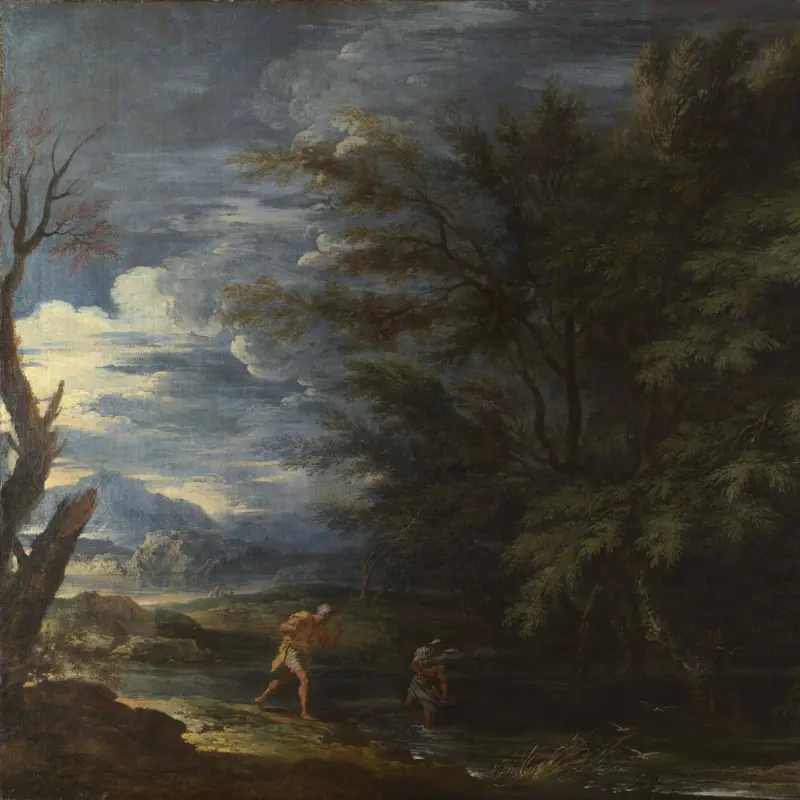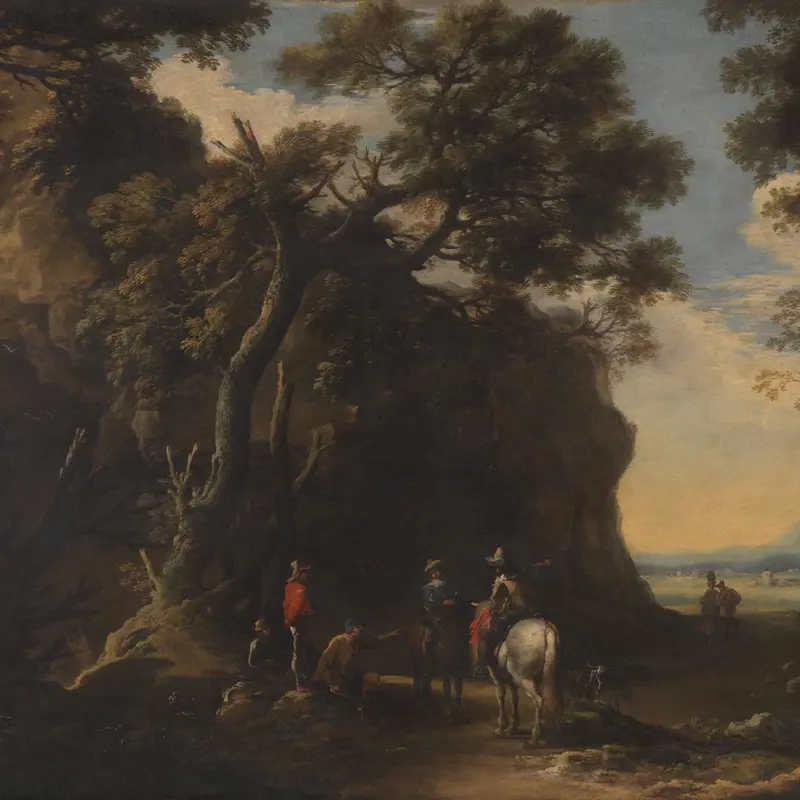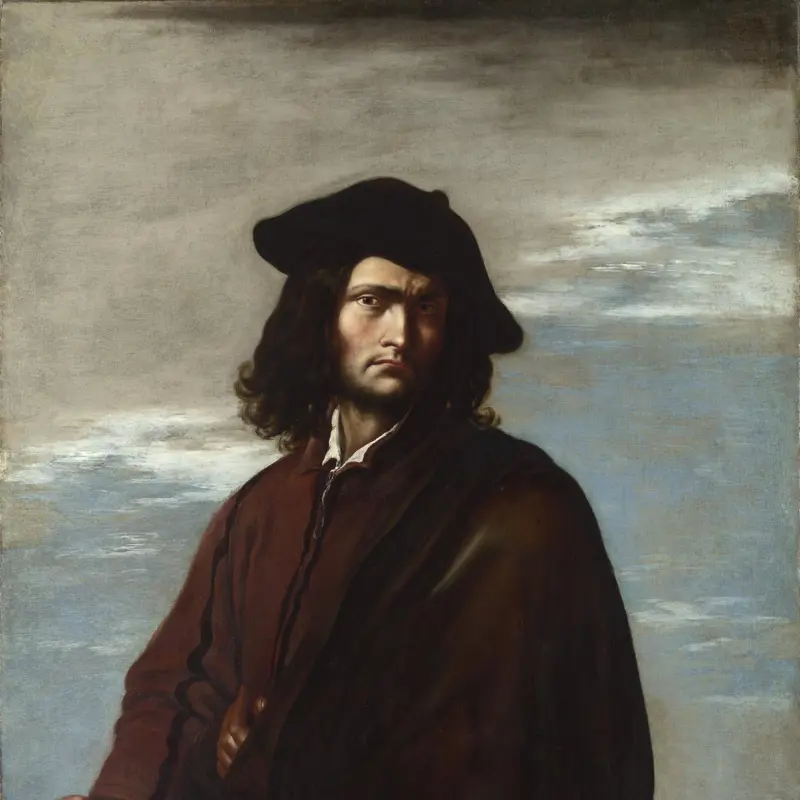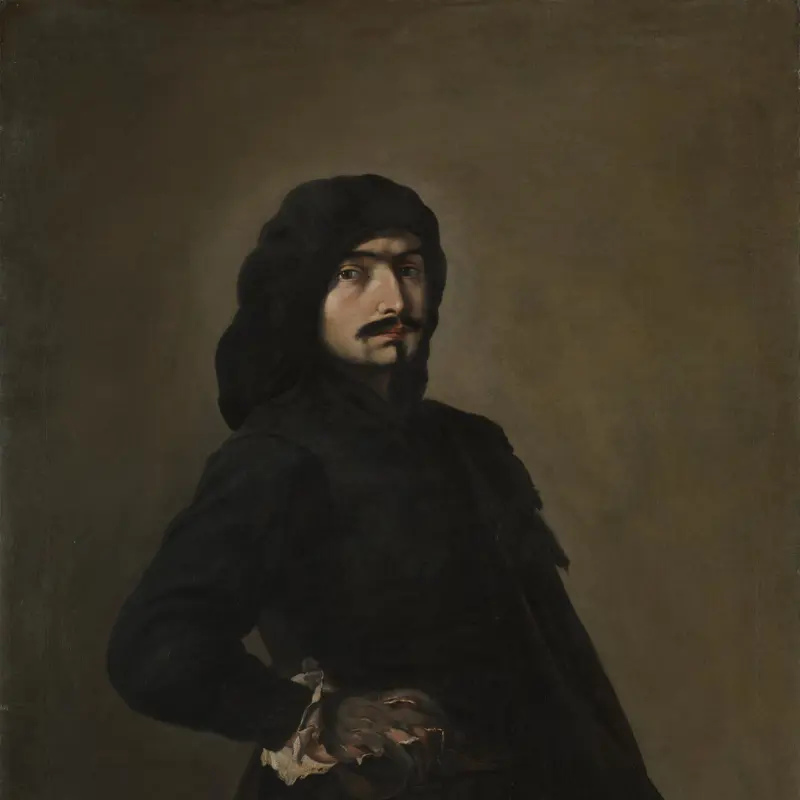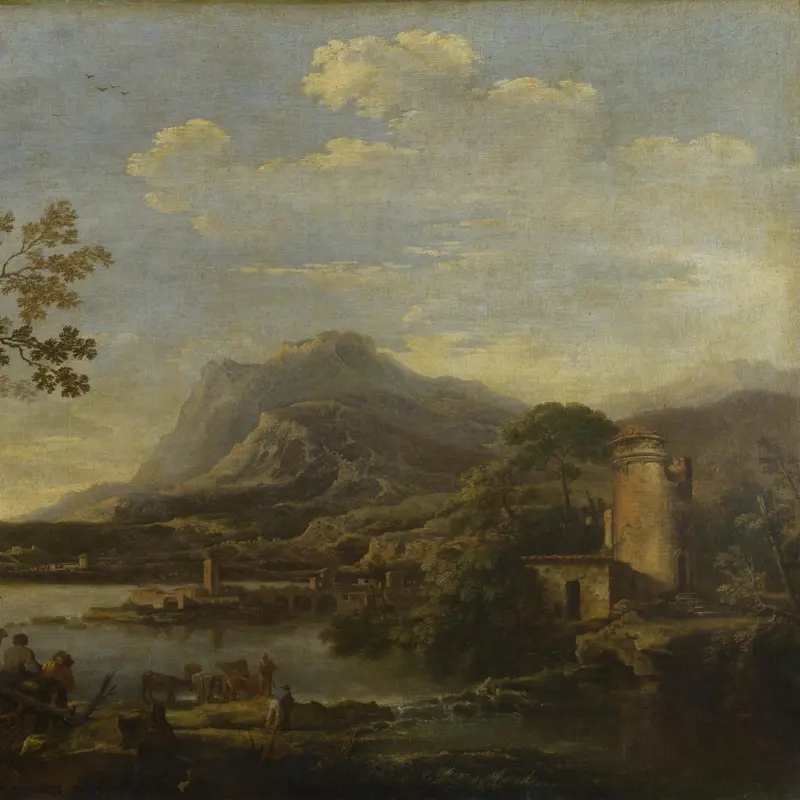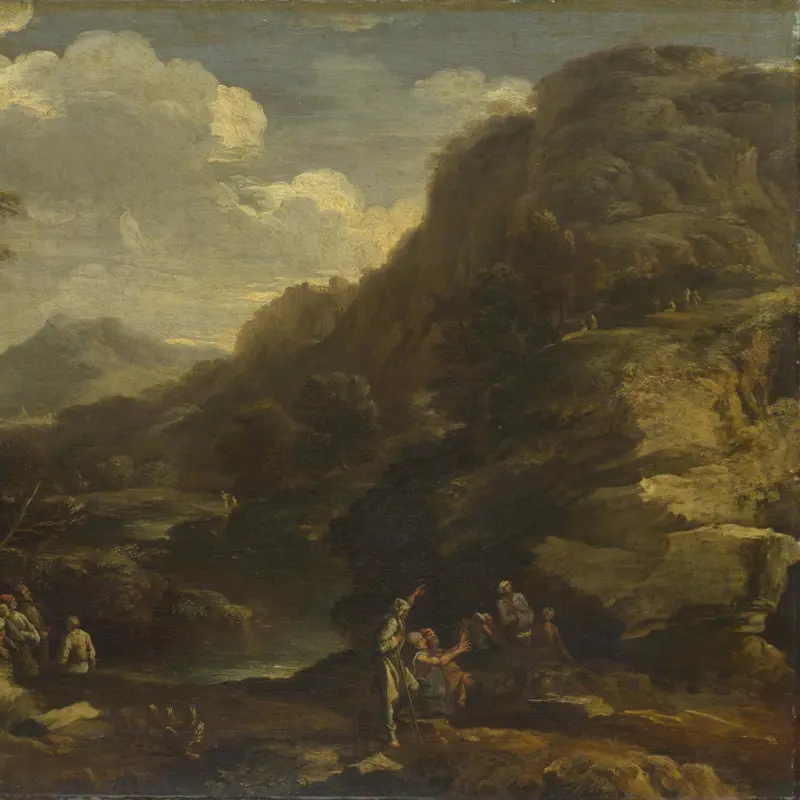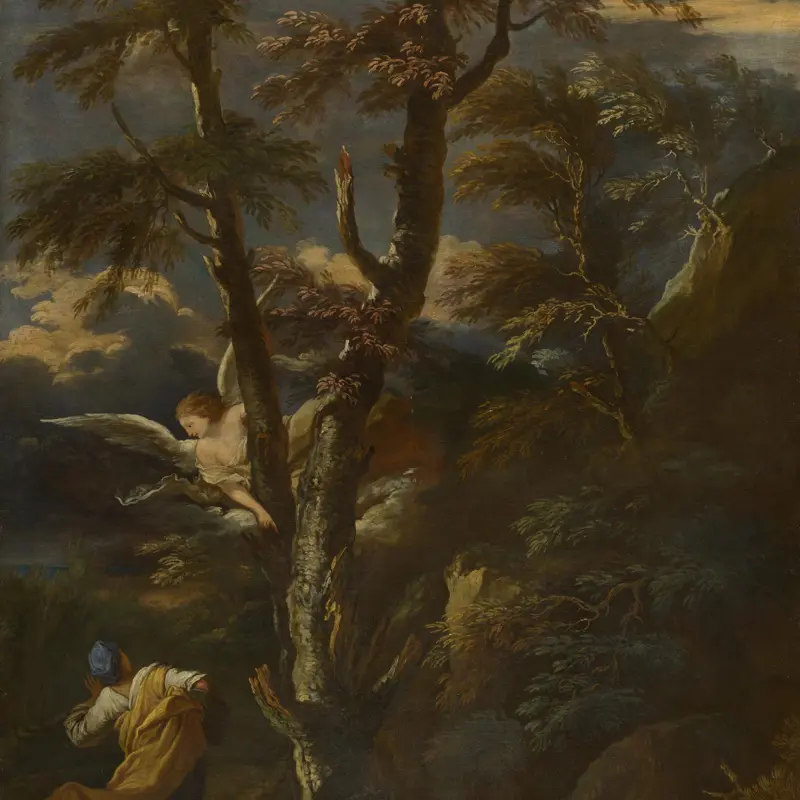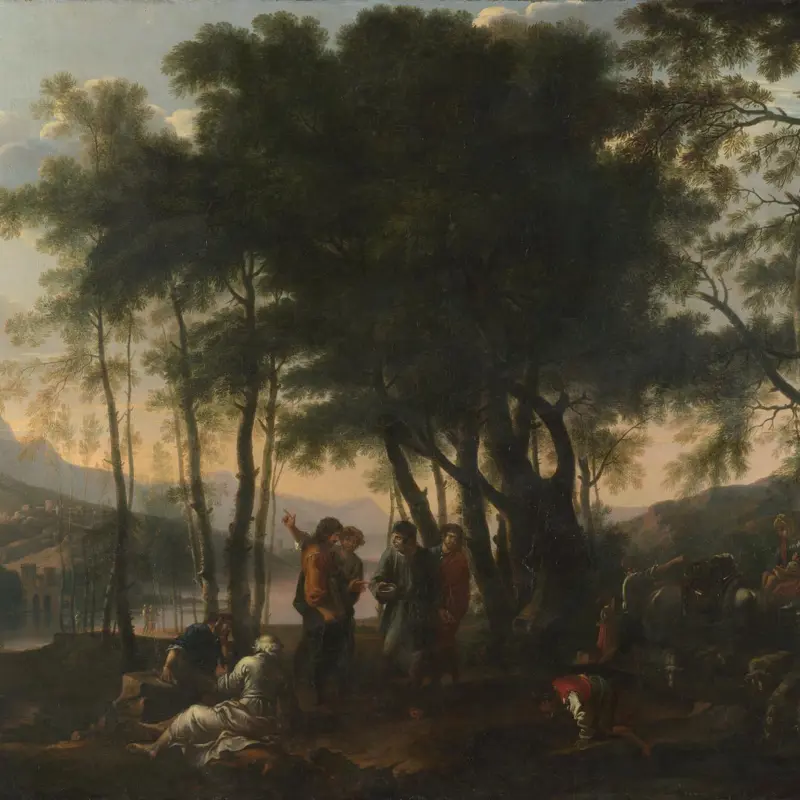Salvator Rosa, 'Witches at their Incantations', about 1646
About the work
Overview
Beneath a pitch-dark sky, bizarre and terrifying magical spells are being cast. Monstrous figures, some of them naked, are arranged as if on a stage set, illuminated by scattered pools of light.
In the centre, one witch smokes the corpse of a criminal that hangs from a withered tree while her companion cuts its toenails. In front of them, naked witches use a wax effigy to cast a love spell; another, surrounded by a catalogue of magical aids, stirs a cauldron. On the extreme left, two men exhume a corpse and force it to sign a document while away to the right, a swaddled infant is held above the gaping jaws of a monster.
This macabre scene evokes a witches' sabbath, a gathering where the devil was worshipped. Salvator Rosa developed an interest in the supernatural while working in Florence in the 1640s and probably painted this remarkable picture around 1646.
Audio description
Listen to an audio description of Salvator Rosa's 'Witches at their Incantations'
Transcript
This is a description of 'Witches at their Incantations' by the Italian artist Salvator Rosa. It is oil on canvas, painted in about 1646. It measures about 130cm wide by 70 cm high, and is in a decorative gilded frame.
This dark painting depicts a gathering of around 20 figures beneath a cloud covered night sky. They are taking part in a variety of bizarre, gruesome and terrifying acts of witchcraft. Some are humans, there to be sacrificed or provide ingredients for spells being cast. Many of their witchy tormentors are naked, and some take the form of monstrous, skeletal beasts. They are arranged along the foreground of the painting, as though across a stage set, illuminated only by scattered pools of light from candles and torches, leaving any other sinister activities in the shadows to our imagination.
The figures are congregated on the earthen floor in three main groups. On the left they huddle in the shadow of a large rock behind them. A ghoulish standing figure, covered entirely in a white sheet, with cut out eye holes, is crowned and garlanded with greenery, holding a hoop of candles. These illuminate two hunched figures who are exhuming a skeleton from its wooden coffin, forcing it to sit up and sign a document with its bony hand.
The group in the centre attend to their incantations in front of a dead tree with withered, gnarly branches. From it hangs a corpse, his neck cruelly extended, head hanging at a 90 degree angle. A witch holds up a flaming pot, smoking the corpse, and a man at his feet works with scissors, harvesting the toenails.
In front of the corpse, a naked witch sits at a stone table, amidst a few gawping observers, their bare flesh gleaming in the firelight. In one hand she holds a small doll-like effigy which is reflected in a small mirror held in her other hand.
To the right, down on the ground, a naked white-haired crone with sagging breasts is hunched over a metal pot between her legs. From something clenched in her hand she squeezes blood into the cauldron, while in the other hand she holds a bone. She consults a recipe from a sheet of paper nailed to the ground beside her, together with magical aids; playing cards, skull, coins, herbs, a knife and various jars.
Moving to the right of the painting, a huge skeletal bird with a long sharp beak is almost as tall as the dead tree with the hanged man. The dark shadows of a forest behind, it looms over the figures below. In front of it, a man in armour is setting light to a white hare with a torch. The hare is on a sheet of paper on which magic symbols are scrawled, the paper pinned within a magic circle drawn on the ground, surrounded by candles. The armoured figure is doing the bidding of two men behind him, one holding a broom across his back. His companion holds a sword, upon which a human heart is impaled.
Last in line on the far right, a giant turtle-like beast with wide grinning jaws and bones for arms is ridden by an elderly witch. She holds a swaddled infant who she appears to be posting into a gaping hole in the creatures shelled back.
During the sixteenth and seventeenth centuries, it was still common for people to be accused of, and executed for supposed acts of witchcraft and sorcery. Salvator Rosa settled in Florence in 1640, and became part of a group of intellectuals, scientists and artists who shared a fascination with the supernatural and the occult.
Rosa probably painted this picture for a Florentine banker and collector Carlo Rossi. According to a letter written by Rosa, the unsettling painting was hung behind a curtain at the end of a long gallery so that it could be dramatically revealed to unsuspecting visitors!
Key facts
Details
- Full title
- Witches at their Incantations
- Artist
- Salvator Rosa
- Artist dates
- 1615 - 1673
- Date made
- About 1646
- Medium and support
- Oil on canvas
- Dimensions
- 72 × 132 cm
- Inscription summary
- Signed
- Acquisition credit
- Bought, 1984
- Inventory number
- NG6491
- Location
- Room 32
- Collection
- Main Collection
- Frame
- 18th-century Roman Frame
Provenance
Additional information
Text extracted from the ‘Provenance’ section of the catalogue entry in Michael Levey, ‘National Gallery Catalogues: The Seventeenth and Eighteenth Century Italian Schools’, London 1986; for further information, see the full catalogue entry.
Exhibition history
-
2010Salvator Rosa (1615 - 1673): Bandits, Wilderness and MagicDulwich Picture Gallery15 September 2010 - 28 November 2010Kimbell Art Museum12 December 2010 - 27 March 2011
-
2013Witches and Wicked BodiesScottish National Gallery of Modern Art26 July 2013 - 3 November 2013
-
2014Bassifondi del Barocco. Roma dei vizi, della miseria e degli eccessi. / Les Bas-fonds du baroque. La Rome des vices, de la misère et des excèsPetit Palais, Musée des Beaux Arts de la Ville de Paris24 February 2015 - 24 May 2015
-
2018Spellbound: Magic, Ritual and WitchcraftThe Ashmolean Museum of Art and Archaeology31 August 2018 - 6 January 2019
-
2021Creating a National CollectionSouthampton City Art Gallery28 May 2021 - 2 September 2021
Bibliography
-
1824S. Morgan, The Life and Times of Salvator Rosa, London 1824
-
1888G. Redford, Art Sales: A History of Sales of Pictures and other Works and Art, with Notices of the Collections Sold, Names of Owners, Titles of Pictures, Prices and Purchasers, 2 vols, London 1888
-
1908L. Ozzola, Vita e opera di Salvator Rosa, pittore, poeta, incisore con poesie e documenti inediti, Strasbourg 1908
-
1924H. Voss, Die Malerei des Barock in Rom, Berlin 1924
-
1963L. Salerno, Salvator Rosa, Milan 1963
-
1974H. Langdon, 'Salvator Rosa in Florence, 1640-1649', Apollo, C/151, 1974, pp. 190-7
-
1975L. Salerno, L'opera completa di Salvator Rosa, Milan 1975
-
1978W.W. Roworth, Pictor Succensor: A Study of Salvator Rosa as Satirist, Cynic and Painter, New York 1978
-
1978L. Salerno and I. Kohn, 'Four Witchcraft Scenes by Salvator Rosa', Bulletin of the Cleveland Museum of Art, LXV/7, 1978, pp. 225-31
-
1985National Gallery, The National Gallery Report: January 1982 - December 1984, London 1985
-
1986Levey, Michael, National Gallery Catalogues: The Seventeenth and Eighteenth Century Italian Schools, London 1986
-
1986M. Helston, 'Some Recently Cleaned Seicento Paintings at the National Gallery', The Burlington Magazine, CXXVIII/996, 1986, pp. 209-17
-
1987J.P. Davidson, The Witch in Northern European Art, Freren 1987
-
1991L. Salerno, 'Due momenti singolari di Salvator Rosa', Artibus et historiae, XII/23, 1991, pp. 121-8
-
1995J. Scott, Salvator Rosa: His Life and Times, New Haven 1995
-
1997K. Sloan, 'Sir William Hamilton's "Insuperable Taste for Painting"', Journal of the History of Collections, IX/2, 1997, pp. 205-27
-
2001
C. Baker and T. Henry, The National Gallery: Complete Illustrated Catalogue, London 2001
-
2004A. Campoli, 'Le "stregonerie" di Salvator Rosa', in S. Macioce (ed.), L'incantesimo di Circe: Temi di magia nella pittura da Dosso Dossi a Salvatore Rosa, Rome 2004, pp. 158-80
-
2004C. Zika, 'The Corsini Witchcraft Scene by Salvator Rosa: Magic, Violence and Death', in D.R. Marshall (ed.), The Italians in Australia: Studies in Renaissance and Baroque Art, Florence 2004, pp. 179-190
-
2005L.C. Hults, The Witch as Muse: Art, Gender and Power in Early Modern Europe, Philadelphia 2005
-
2006G. Tal, Witches on Top: Magic, Power, and Imagination in the Art of Early Modern Italy, Indiana 2006
-
2008S. Cassani, Salvator Rosa: Tra mito e magia (exh. cat. Museo di Capodimonte, 18 April - 29 June 2008), Naples 2008
About this record
If you know more about this work or have spotted an error, please contact us. Please note that exhibition histories are listed from 2009 onwards. Bibliographies may not be complete; more comprehensive information is available in the National Gallery Library.

